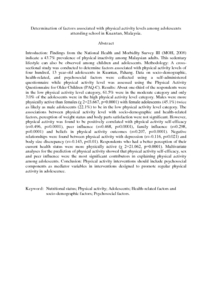Citation
Dan, S.P. and Mohd Shariff, Zalilah and Mohd Taib, Mohd Nasir
(2011)
Determination of factors associated with physical activity levels among adolescents attending school in Kuantan, Malaysia.
Malaysian Journal of Nutrition, 17 (2).
pp. 175-187.
ISSN 1394-035X
Abstract
Introduction: Findings from the National Health and Morbidity Survey III (MOH, 2008) indicate a 43.7% prevalence of physical inactivity among Malaysian adults. This sedentary lifestyle can also be observed among children and adolescents. Methodology: A cross-sectional study was conducted to determine factors associated with physical activity levels of four hundred, 13 year-old adolescents in Kuantan, Pahang. Data on socio-demographic, health-related, and psychosocial factors were collected using a self-administered questionnaire while physical activity level was assessed using the Physical Activity Questionnaire for Older Children (PAQ-C). Results: About one-third of the respondents were in the low physical activity level category, 61.5% were in the moderate category and only 3.0% of the adolescents were in the high physical activity level category. Males were more physically active than females (χ 2=23.667, p=0.0001) with female adolescents (45.1%) twice as likely as male adolescents (22.1%) to be in the low physical activity level category. The associations between physical activity level with socio-demographic and health-related factors, perception of weight status and body parts satisfaction were not significant. However, physical activity was found to be positively correlated with physical activity self-efficacy (r=0.496, p=0.0001), peer influence (r=0.468, p=0.0001), family influence (r=0.298, p=0.0001) and beliefs in physical activity outcomes (r=0.207, p=0.0001). Negative relationships were found between physical activity with depression (r=-0.116, p=0.021) and body size discrepancy (r=-0.143, p<0.01). Respondents who had a better perception of their current health status were more physically active (χ 2=21.062, p=0.0001). Multivariate analyses for the prediction of physical activity showed that physical activity self-efficacy, sex and peer influence were the most significant contributors in explaining physical activity among adolescents. Conclusion: Physical activity interventions should include psychosocial components as mediator variables in interventions designed to promote regular physical activity in adolescence.
Download File
![[img]](http://psasir.upm.edu.my/24652/1.hassmallThumbnailVersion/Determination%20of%20factors%20associated%20with%20physical%20activity%20levels%20among%20adolescents%20attending%20school%20in%20Kuantan.pdf)  Preview |
|
PDF (Abstract)
Determination of factors associated with physical activity levels among adolescents attending school in Kuantan.pdf
Download (188kB)
| Preview
|
|
Additional Metadata
Actions (login required)
 |
View Item |

